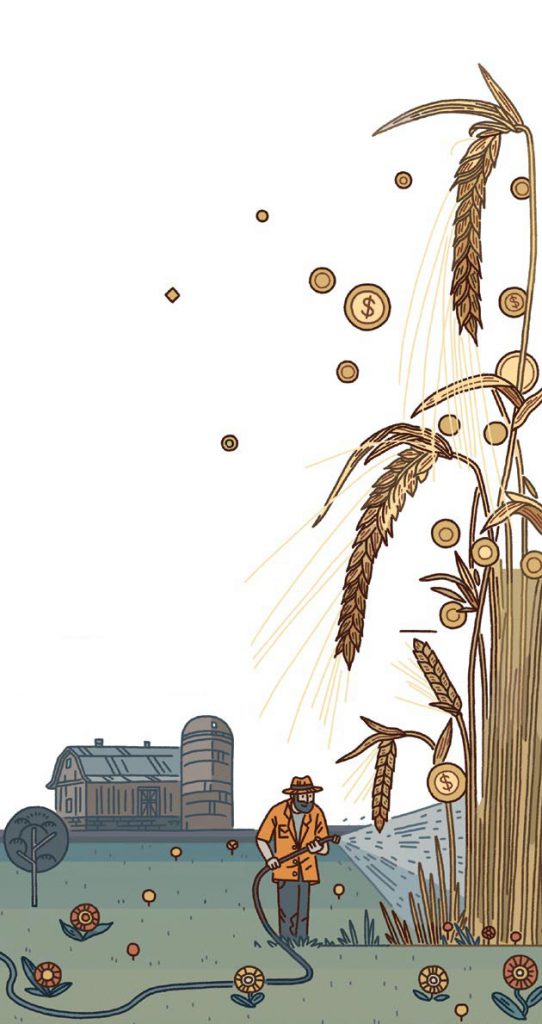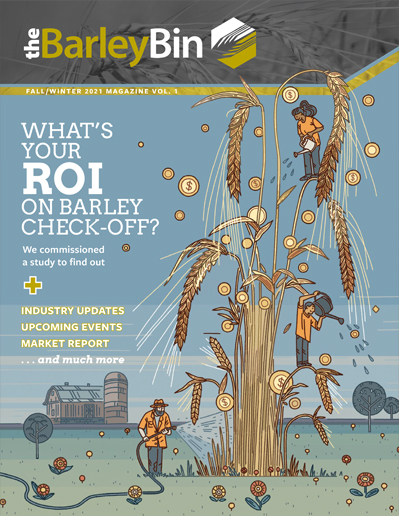The Barley Bin Magazine
Fall / Winter 2021 (Inaugural issue)
Welcome to the Barley Bin magazine, a new bi-annual SaskBarley publication, featuring insider industry information and the latest news on barley production and marketing.
COVER STORY
What’s Your ROI on Barley Check-Off?
Future Funding for Barley Breeding
What if you found out you’re holding an investment that pays out more than $25 for every dollar you put in? It turns out, you are.
by Leeann Minogue
 The future funding of barley breeding programs in Canada has been in the spotlight following the value creation/capture consultations initiated by Agriculture and Agri- Food Canada in 2018-19.
The future funding of barley breeding programs in Canada has been in the spotlight following the value creation/capture consultations initiated by Agriculture and Agri- Food Canada in 2018-19.
SaskBarley asked agricultural economist Richard Gray to look at Western Canadian farmers’ spending in this area. Gray and his co-researchers, Katarzyna Bolek-Callbeck and Jillian Brown, were asked to find out what kind of return farmers get from levy dollars spent on barley breeding.
This type of research might sound familiar. Richard Gray has spent much of the last decade studying the economics of research. He’s developed methods to calculate what share of returns from crop research actually ends up in farmers’ hands. Gray uses conservative estimates for his calculations, he says, including “numbers that producers can verify themselves.” Gray has done similar work looking at research investments for other crops. However, as barley growers know, barley is a little different, as maltsters and brewers are often slow to adopt new varieties.
WHAT’S THE RETURN?
To estimate farmers’ return on investments in barley breeding, Gray and his co-researchers first calculated how much farmers spent on breeding research from 1995 to 2020, through levies paid on barley sales. A levy of $1.06/tonne on Saskatchewan barley doesn’t seem like enough to make a difference, but when levies across the prairies are totalled over 25 years, the investment reaches $51.5 million (in 2019 dollars).
Next, they calculated what farmers got back. Farmers’ returns from breeding research come mainly from higher yields. Because it takes 10 years to get a new variety from the lab to the field, Gray and his coresearchers looked at varieties released from 2005 to 2019. Then, they forecast these increases out another 10 years, to consider a 25-year period. Based on estimated adoption rates for new varieties, they used these yield increases to calculate the total increase in production. With average and forecast prices, they put a dollar value to these gains. When they multiplied increased production by prices, farmers’ gains came in at $1.360 billion over the 25-year period (again, in 2019 dollars).
With a $1.360 billion revenue increase from an investment of $51.5 million, the ratio of farmers’ benefits to costs is 26. That is, for every $1 invested, $26 is returned to farmers through increased barley yields.
WHY DON’T WE DOUBLE DOWN?
With an investment paying out returns like this, the question that comes to mind is “why aren’t we investing more?” “There are benefits to doing a lot more than we’re doing now,” Gray says. “It’s a little frustrating.” Western Canadian farmers currently spend about one-sixth of one per cent of gross barley revenue in research and breeding. “Farmers could benefit a great deal from investing more,” Gray says, “yet here we sit.”
For a mental picture, Gray suggests imagining getting every barley producer in Western Canada together. “You’d have to go to an arena,” he says.
Then, in the front, imagine every Western Canadian barley breeder. There are five. That’s right, five researchers do all of the barley breeding for all , of Western Canada. There are three in Lacombe, Alberta, at the Field Crop Development Centre, one in Saskatoon at the Crop Development Centre (who also works on oats), and one at the Agriculture and Agri- Food Canada (AAFC) facility in Brandon, Manitoba.
ARE WE COMPETITIVE?
The study commissioned by SaskBarley, titled “Barley Breeding in Canada – A Path Forward,” also compared Canadian investments in barley breeding with competitors’ breeding investments. Australia, they found, spends almost 10 times more than Canada, with funding coming from Australian barley growers. Australian yields are lower than yields in Western Canada, but they are increasing steadily. Over the past 40 years Australia has moved from publicly funded research to research funded primarily by farmer royalties.
In France and Germany, barley breeding funding comes mainly from private companies and so is difficult to assess. Based on the number of breeders in Germany, the authors concluded that Germany spends more than Canada, and Germany has seen some yield increases in recent years. Production in France has remained relatively constant.
Going back to the visual image of Western Canada’s five barley breeders, Jason Skotheim, Saskatchewan farmer and outgoing Director of SaskBarley points out that these five scientists are “really hitting above their weight.” Under their watch, Western Canadian barley yields continue to increase — and maintain a global reputation as a premium product — while the agronomics of barley keep improving, keeping barley relevant in Saskatchewan crop rotations.
HOW DO WE SELL NEW VARIETIES?
As barley growers know, once malt buyers find a variety they like, they’re reluctant to try something new, even when new varieties offer farmers higher yields and better agronomic traits. This complicates investments in barley breeding. Some high-quality varieties are passed over by maltsters and never catch on. Gray considered this problem as part of the research study. He found that if farmers could always grow the top-yielding varieties, the benefit/cost ratio of breeding research could reach as high as 50, approximately doubling current returns on breeding investments.
In this situation, there is a potential danger to releasing too many new varieties. “We don’t want a lot of ‘metoo’s,’” says Jason Skotheim, “where a variety is one or two percent better in a single category. We’d rather have fewer varieties, because then it sends a clear signal to the supply chain.” SaskBarley is working in this area, Skotheim says. “We’ve been doing a lot of market development work to try to get our market to understand that we need higher levels of churn in the varieties we grow.”
The rise of craft microbreweries and the “buy local” movement present opportunity in this area. Local buyers for niche markets could provide a market for new, high-yielding varieties that are not accepted by large-scale maltsters.
WHAT’S IN THE FUTURE?
Future public funding for barley breeding research is uncertain. AAFC has sent signals that investment in variety development will be pulled back, and COVID-19 may further impact future government spending. In the fall of 2018, AAFC held a series of public consultations on new “value creation” models, or new ways to fund breeding research. These consultations included barley alongside other cereals, without special consideration for the effects of malt selection. There were no clear results from these consultations.
In this environment, Gray’s study concludes that farmers should be confident that their levy payments have resulted in higher profits, and should dedicate more check-off funding to barley breeding programs. Gray says, “The biggest question is, ‘Why not do more?’”
SaskBarley recognizes those returns and allocates over 70% of its annual budget to research with a significant portion of those dollars in variety development, with an aim to continue developing exciting and high-yielding barley varieties, Skotheim says.
“The value proposition that research presents to producers is significant,” says Jason Skotheim.” “Every farmer should be leaving their check-offs with the crop commissions.”


